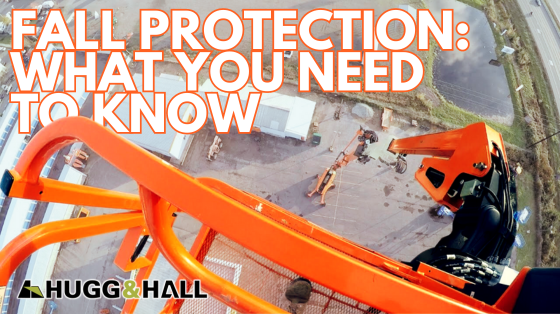
Fall Protection: What You Need to Know
Did you know? In 2022, falls were the leading cause of on-the-job deaths for construction workers.
Mobile Elevating Work Platforms (MEWPs) are so commonplace on jobsites and in warehouses that many employees stop seeing fall protection as a potential life-saving measure.
Under OSHA regulations, fall protection must be used at elevations of 6 feet in the construction industry.
Your employer is responsible for providing OSHA-approved fall protection. As the MEWP operator or user, you are responsible for using that fall protection.
Types of Fall Protection
For MEWPs, personal fall protection systems (i.e. harnesses) must meet specific requirements to be OSHA-compliant.
These requirements involve calculating fall distance and potential arresting force. They must not allow an operator to fall more than six feet or exceed 1,800 pounds in arresting force.
A note on calculating fall distance appears after this section.
Fall restraint
A fall restraint system prevents workers from falling or being thrown from a platform. They will keep you from falling in the first place, but they can limit your movement as you’re working.
This system uses a short or adjustable restraint lanyard attached to a body belt or full-body harness.
You must use a fall restraint lanyard whenever the lift is traveling and when the platform height is below the calculated total fall distance. If you were to use a fall arrest system during either of these times, it would not keep you from hitting the ground.
Fall arrest
A full-body harness with self-retracting life/lanyard system minimizes the distances and consequences of a fall, should one occur. They provide greater freedom of movement, but do not prevent you from falling off a platform. They will simply keep you from hitting the ground.
This system uses a self-retracting lifeline attached to a full-body harness.
You can use a fall arrest lanyard when the platform height is above the calculated total fall distance.
Calculating Total Fall Distance for Fall Arrest Systems
The required fall clearance distance = the length of the lanyard + the deceleration distance + the height of the suspended worker + a safety factor.
Note: the safety factor is any height of a suitable amount to ensure that the required clearance between the operator and the lower surface is met. This includes:
- Any stretch in the lifeline or lanyard outside of the deceleration distance
- Any harness effects
- Any movement of the platform due to dynamic loading
- Any obstructions under the platform
It’s a complex-looking equation, but it’s actually pretty easy to calculate once you’re familiar with it.
Consider the equation x = a + b + c + d. Sub out your variables for the following, and you’ll have an easy equation.
- x = total required fall clearance distance
- a (length of lanyard) = 6 feet
- b (maximum allowable deceleration distance) = 4 feet
- c (height of suspended worker) = 6 feet
- d (safety factor) = 1.5 feet
Therefore,
x = 6 + 4 + 6 + 1.5, or
x = 17.5 feet of fall distance from the ground or nearest obstruction.
Note: these variables change for different heights, weights, and situations and only apply to lanyards compliant with OSHA and ANSI.
- Free fall over 6 feet (up to 12 feet)? Add 1 foot to b (deceleration distance)
- Weight over 310 pounds (up to 410 pounds)? Add 1 foot to b (deceleration distance)
Additional Fall Protection Requirements
OSHA also requires the following:
- Ensure that access gates or openings are closed.
- Stand firmly on the floor of the bucket or lift platform.
- Do not climb on or lean over guardrails or handrails.
- Do not use planks, ladders, or other devices as a working position.
- Use a body harness or a restraining belt with a lanyard attached to the boom or bucket.
- Do not belt-off to adjacent structures or poles while in the bucket.
Takeaways
There are two distinct ways to protect yourself from falling from a MEWP platform. It’s up to you, your employer, and the situation to determine how to protect yourself from falling.
This post was originally published in June 2019. We updated it for freshness and accuracy in May 2024.
Back to News
Subscribe and unlock cutting-edge equipment insights, trends and tips!
Subscribe